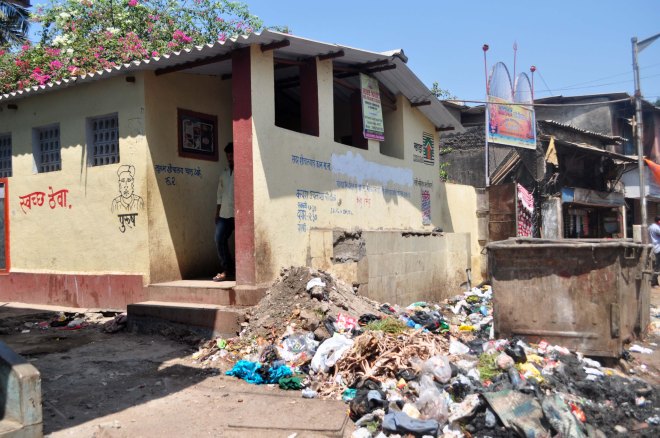A 2006 UNDP Human Development Report made an almost unbelievable estimate of one toilet for every 1440 people in Dharavi. It went on to describe the situation: “In the rainy season, streets, lacking drainage, become channels for filthy water carrying human excrement.” “People in Dharavi rely on wells, tankers or unsafe sources for their drinking water. In a typical case, 15 families share one tap that works for two hours a day." If reports are not enough, there was the 2008 flim Slumdog Millionaires's exaggerated graphic depiction of the boy-jumping-into-a-shit-hole scene in Dharavi. Toilets, sanitation and the recent rise in reported rape cases across the nation that coincide with this lack of toilet facilities, made us want to get some insider stories through candid conversations with Dharavi Biennale participants. Anjali Amma, around 55 years old, lives in Pila Bangla in a house right next to a common toilet block. Her son got married earlier this year and she was worried about wedding guests commenting on the mucky state of the toilets. Unable to bear the stench, she decided to do her part by cleaning them herself. “Everybody praises me for it, but no one comes forward to clean the toilets. I couldn't dream of my son’s wedding taking place without a clean loo next door,” she says.
The state of disrepair of common toilet units is a familiar story. While the adjectives describing them are unpleasant to the senses, the list of problems is specific: lack of water supply, safety hazards for women and children, poor maintenance and lack of a sense of sanitation. The overarching problem seems to be that there are very few toilets in working condition and many people who need them.
Moreover, what are the choices that Dharavi people make? The desire to reside in a central location of Mumbai like Dharavi has overpowered the necessity to leave room to build more toilets. The choice residents make is to stand in long queues rather than relinquish their home space. It raises a debatable question on urban health on which is a more serious predicament: living in dingy small spaces that breed diseases or using badly maintained common toilet blocks.
If the authorities do not do their part to keep the toilets clean, residents like Anjali Amma have taken matters into their own hands. She and her neighbours each put in Rs. 30 every month (one rupee per day) and take turns to clean the toilets themselves. She has even taken the initiative of making a lock for the toilets so those with no interest in paying up do not misuse them. Unfortunately they keep breaking the locks, she says.
Malati Murkar, a resident of New Kamala Nagar near the polluted Mithi river, says that she and her neighbours contributed Rs. 500 each some years ago so that they could have a common, exclusive toilet block. While they deal with the problem of broken locks, they still manage to maintain the sanitation. “We take water and bleaching powder from home every weekend and wash the toilet. Every lady who uses it washes it,” she says. One may wonder why the men in their families don’t help their wives, mothers, daughters and sisters, but Malati recalls that when her two sons were younger they would have to be careful venturing out at night to use the nearby toilet.
19 year old Saiba Kadir also hesitates to use common toilets and it is normal for women visit the toilets in groups. Her younger sister Fareeda, who is 13, says that she is unafraid, although she has heard of ‘bad things’ happening to girls who go to the toilets alone at night. She chuckles and says, “I travel all alone to my school in Bandra by train. I am usually the one who reassures my sister if we are ever alone in a place.”
Luckily, the long lines outside their local toilets mean that there are people around, even at midnight. Bhagyashree Alkunte, a friend and neighbour, says that so many people need to use them before and after dinner that four toilets can’t possibly meet the needs of the area. Saiba says that they have requested (she doesn't know to whom) a toilet to be built above the gutters, but her family and neighbours are rethinking the idea because the gutters flood in the monsoons.
Another group of girls, who did not wish to be named, say that the visiting the toilets in the wee hours of the morning is a golden opportunity for them for some girl-talk. Living in mostly one-room houses where privacy is hard to come by, stepping out to use the toilets is a good excuse to share the latest neighbourhood gossip on lovers and relationships and nagging in-laws. One girl says that she takes her mobile phone with her and makes a quick good morning call to her boyfriend in the privacy of the loo.
Sitaram Kharat, Dharavi Biennale's logistician, feels that private-public partnerships may be the way to go for improved and safe sanitation services. In his locality, Naik Nagar, an NGO named SPARC teamed up with the MHADA some years ago to set up three well maintained block of toilets that are rumoured to be some of the best in Dharavi. Each block has about 22 toilets with regular water supply. "Back in the 1990's, people in my locality used the BMC's open maidan as a toilet. When the BMC stationed a construction company's on-site office in the maidan, that is when the need for an actual toilet arose. Before that, could you believe that people in my locality didn't actually use a toilet?" he wonders.

